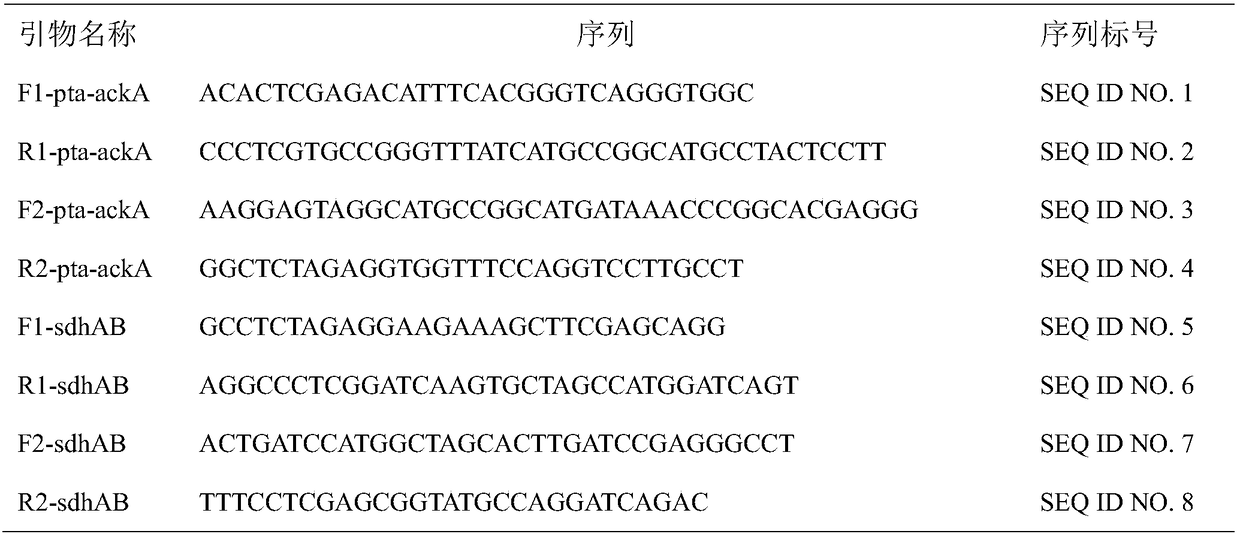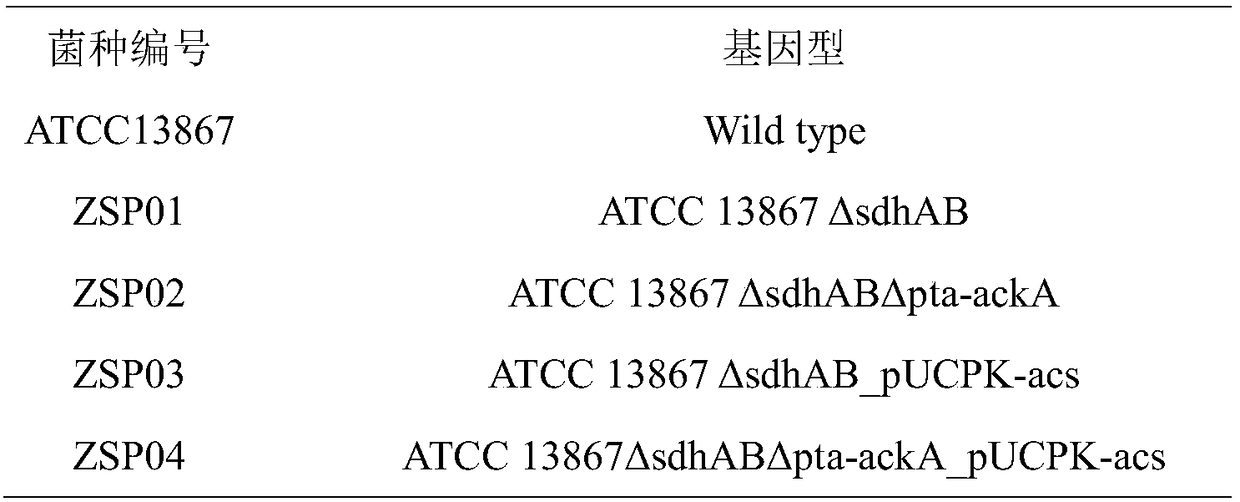Metabolic engineering pseuomonas denitrifican for producing succinic acid as well as construction method and application of pseuomonas denitrifican
A technology of Pseudomonas denitrogenation and metabolic engineering, which is applied in the field of Pseudomonas denitrogenation of metabolic engineering for producing succinic acid, and achieves the effects of wide source of raw materials and low cost
- Summary
- Abstract
- Description
- Claims
- Application Information
AI Technical Summary
Problems solved by technology
Method used
Image
Examples
Embodiment 1
[0018] Example 1. Knockout of genes to obtain succinic acid producing strains
[0019] The gene sdhAB was knocked out using the traceless knockout fund technique. The specific operation is as follows:
[0020] For the knockout of gene sdhAB, at first use the sequence as the primer (F1-sdhAB) of SEQ ID NO.1 and the sequence as the primer (R1-sdhAB) of Seq ID NO.2 with Pseudomonas denitrification ATCC13867 genomic DNA as template PCR clones the DNA fragment sdh US of about 500bp of the upstream sequence of the sdhAB gene, and uses the primer (F2-sdhAB) with the sequence of SEQ ID NO.3 and the primer (R2-sdhAB) with the sequence of Seq ID NO.4 to deaza Genomic DNA of bacteria ATCC13867 was used as a template to PCR clone the DNA fragment sdh DS of about 500 bp downstream of the sdhAB gene, and then the sdh US and sdh DS fragments were fused into one fragment sdh del by fusion PCR method, and the fused fragment was cloned into the pQSAK plasmid to form a recombinant Plasmid pQSA...
Embodiment 2
[0026] Example 2. Overexpression of acetyl-CoA synthetase acs
[0027] The acetyl-CoA synthetase gene acs of Pseudomonas denitrifica origin was overexpressed using the plasmid pUCPK. First, the acs gene was amplified by PCR using genomic DNA as a template. The Escherichia coli-Pseudomonas shuttle plasmid pUCPK was digested with XbaI and HindIII, and the acs fragment was ligated to pUCPK. The obtained recombinant plasmid was named pUCPK-acs and sent for sequencing verification.
Embodiment 3
[0028] Embodiment 3 produces Pseudomonas succinate strain shaking flask fermentation
[0029] Using Pseudomonas ATCC13867 as the starting strain, the sdhAB gene was knocked out, the TCA cycle was blocked, and the succinic acid-producing basic strain ZSP01 was obtained
[0030] On the basis of the single deletion strain, the pta-ackA gene was knocked out to obtain the strain ZSP02.
[0031] After the above strains were constructed, they were stored in glycerol (20%, v / v). The completed plasmid pUCPK-acs was used to transform each deletion strain, and the recombinant bacteria overexpressing the acs gene were obtained, which were named ZSP01-acs and ZSP02-acs. Shake flask fermentation was used to verify the fermentation performance of each strain.
[0032] Pseudomonas strains ZSP01, ZSP02 and recombinant strains ZSP01-acs, zsp-acs were cultured on LB plates overnight. A single colony from the fresh plate was inoculated into a 50 mL Erlenmeyer flask containing 10 mL of seed med...
PUM
 Login to View More
Login to View More Abstract
Description
Claims
Application Information
 Login to View More
Login to View More - R&D
- Intellectual Property
- Life Sciences
- Materials
- Tech Scout
- Unparalleled Data Quality
- Higher Quality Content
- 60% Fewer Hallucinations
Browse by: Latest US Patents, China's latest patents, Technical Efficacy Thesaurus, Application Domain, Technology Topic, Popular Technical Reports.
© 2025 PatSnap. All rights reserved.Legal|Privacy policy|Modern Slavery Act Transparency Statement|Sitemap|About US| Contact US: help@patsnap.com


